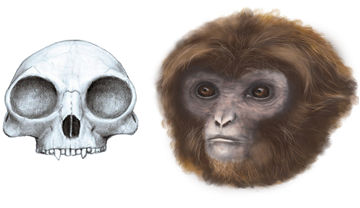
L’estudi morfomètric del fèmur del primat fòssil Aegyptopithecus zeuxis ha revelat que l’estructura del maluc (una part de l’anatomia molt relacionada amb el sistema locomotor) dels cercopitècids (o mones del Vell Món) i els hominoïdeus (que inclouen els simis antropomorfs com els ximpanzés i els humans) va divergir evolutivament—en direccions oposades—a partir d’una forma primitiva de l’Oligocè.

Researchers from the Stony Brook University and the Institut Català de Paleontologia Miquel Crusafont (ICP) analyze in an article published in Proceedings of the National Academy of Sciences (PNAS) how the morphology of toes changed to allow bipedal locomotion in earlier hominins. The study also reveals that the big toe retained its prehensile capacity until relatively recent times.

Un estudi publicat a la revista American Journal of Physical Anthropology per un equip d’investigadors internacionals revela que els goril·les de muntanya es desplacen recolzant les mans al terra de formes molt diferents i no només amb els artells, com es creia fins ara. Un 40% dels individus estudiats presentaven formes diferents de recolzament, algunes mai vistes a goril·les. La troballa posa en qüestió el model actual d’evolució del bipedisme en els hominins.
 A team of researchers from the ‘Institut Català de Paleontologia Miquel Crusafont’ describes in the Science magazine the new genus and species, Pliobates cataloniae, based on a skeleton recovered from the landfill of Can Mata (els Hostalets de Pierola, Catalonia, Spain). The fossil remains belong to an adult female individual named “Laia” by her discoverers. “Laia” weighed 4-5 kg, consumed soft fruit items and moved through the forest canopy by climbing and suspending below branches. Pliobates lived 11.6 million years ago and precedes the divergence between hominids (great apes and humans) and hylobatids (gibbons), which has important implications for reconstructing the last common ancestor of both groups.
A team of researchers from the ‘Institut Català de Paleontologia Miquel Crusafont’ describes in the Science magazine the new genus and species, Pliobates cataloniae, based on a skeleton recovered from the landfill of Can Mata (els Hostalets de Pierola, Catalonia, Spain). The fossil remains belong to an adult female individual named “Laia” by her discoverers. “Laia” weighed 4-5 kg, consumed soft fruit items and moved through the forest canopy by climbing and suspending below branches. Pliobates lived 11.6 million years ago and precedes the divergence between hominids (great apes and humans) and hylobatids (gibbons), which has important implications for reconstructing the last common ancestor of both groups.






